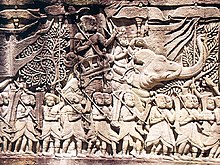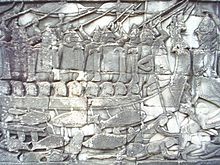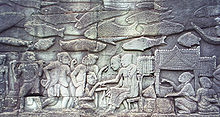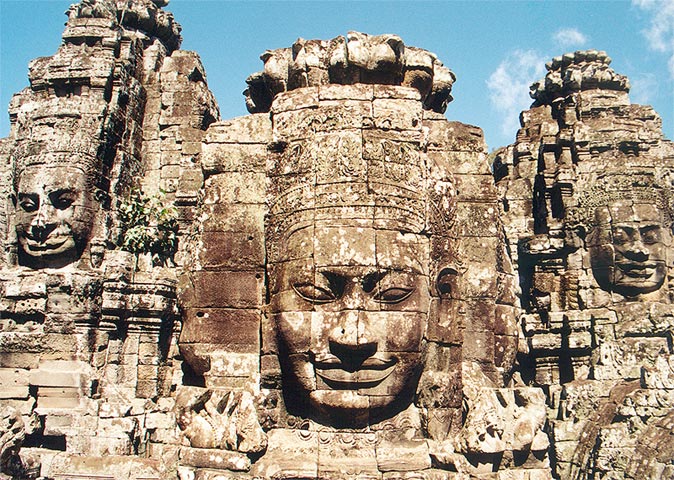The outer gallery: historical events and everyday life
The outer wall of the outer gallery features a series of bas-reliefs depicting historical events and scenes from the everyday life of the Angkorian Khmer. Though highly detailed and informative in themselves, the bas-reliefs are not accompanied by any sort of epigraphic text, and for that reason considerable uncertainty remains as to which historical events are portrayed and how, if at all, the different reliefs are related. From the eastgopura clockwise, the subjects are:
- in the southern part of the eastern gallery a marching Khmer army (including some Chinese soldiers), with musicians, horsemen, and officers mounted on elephants, followed by wagons of provisions;
- still in the eastern gallery, on the other side of the doorway leading into the courtyard, another procession followed by domestic scenes depicting Angkorian houses, some of the occupants of which appear to be Chinese merchants;
- in the southeast corner pavilion, an unfinished temple scene with towers, apsaras, and a lingam;
- in the eastern part of the southern gallery, a naval battle on the Tonle Sap between Khmer and Cham forces, underneath which are more scenes from civilian life depicting a market, open-air cooking, hunters, and women tending to children and an invalid;
- still in the southern gallery, past the doorway leading to the courtyard, a scene with boats and fisherman, including a Chinese junk, below which is a depiction of a cockfight; then some palace scenes with princesses, servants, people engaged in conversations and games, wrestlers, and a wild boar fight; then a battle scene with Cham warriors disembarking from boats and engaging Khmer warriors whose bodies are protected by coiled ropes, followed by a scene in which the Khmer dominate the combat, followed by a scene in which the Khmer king celebrates a victory feast with his subjects;
- in the western part of the southern gallery, a military procession including both Khmers and Chams, elephants, war machines such as a large crossbow and a catapult;
- in the southern part of the western gallery, unfinished reliefs show an army marching through the forest, then arguments and fighting between groups of Khmers;
- in the western gallery, past the doorway to the courtyard, a scene depicting a melee between Khmer warriors, then a scene in which warriors pursue others past a pool in which an enormous fish swallows a small deer;[15] then a royal procession, with the king standing on an elephant, preceded by the ark of the sacred flame;
- in the western part of the northern gallery, again unfinished, a scene of royal entertainment including athletes, jugglers and acrobats, a procession of animals, ascetics sitting in a forest, and more battles between Khmer and Cham forces;
- in the northern gallery, past the doorway to the courtyard, a scene in which the Khmer flee from Cham soldiers advancing in tight ranks;
- in the northeast corner pavilion, another marching Khmer army;
- in the eastern gallery, a land battle between Khmer and Cham forces, both of which are supported by elephants: the Khmer appear to be winning.
The outer gallery encloses a courtyard in which there are two libraries (one on either side of the east entrance). Originally the courtyard contained 16 chapels, but these were subsequently demolished by the Hindu restorationist Jayavarman VIII.











